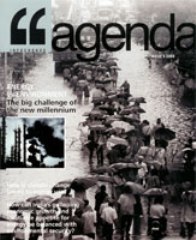/regions/political
Political
Uttar Pradesh Urban Sanitation Policy - Jawaharlal Nehru National Urban Renewal Mission - Government of India (2010)
Posted on 18 Jun, 2011 10:41 PMThe factors that lead to this poor sanitation situation in the city include:
Capacity and investment in the water supply and sanitation sectors - Guidelines in respect of participation of cooperative institutions (2006) - Water Supply and Sanitation Department (Government of Maharashtra)
Posted on 18 Jun, 2011 10:20 PMIt argues that this is because civil bodies are facing many problems due to urbanisation and increasing demand from the residents. There is a need to increase efficiency in the water supply and sewage.
Rainwater harvesting in urban areas of Karnataka (Government of Karnataka) - Draft policy (2006)
Posted on 18 Jun, 2011 10:16 PMThe Rainwater Harvesting Policy (2006) for Karnataka state has evolved out of the need for conserving rainwater and providing facilities for rainwater harvesting, in the context of the growing rate of urbanisation in the state and the rapid depletion of groundwater resources, leading to a water crisis.
The objective of the urban rainwater harvesting policy is to ensure that the available water is put to best possible use in the state by encouraging involvement of multiple level of stakeholders such as government and private institutions as well as citizens, in the appropriate management of rainwater.
Model muncipal law - Ministry of Urban Development and Poverty Alleviation (2003)
Posted on 18 Jun, 2011 10:08 PMThis document includes the details of the Model Municipal Law and includes the details of :
Environmental impact assessment - Notification and amendment (2006) - Ministry of Environment and Forests
Posted on 18 Jun, 2011 10:01 PMThe document emphasises the need for taking prior environmental clearance in case of new projects or activities or expansion of already existing activities in accordance with the objectives of National Environment Policy that has approved by the Union Cabinet on 18th May, 2006 and the procedure specified in the notification, by the Central Government or the State or Union territory Level.
Presentations from the two-day workshop on success stories under watershed programmes by DoLR at New Delhi (2011)
Posted on 18 Jun, 2011 06:50 PMThe workshop was structured in two sections. Research papers were presented from research institutes such as Central Research Institute for Dryland Agriculture (CRIDA), Central Soil & Water Conservation Research and Training Institute (CSWRTI), Deutsche Gesellschaft für Internationale Zusammenarbeit (GIZ) GmbH, International Crops Research Institute for the Semi-Arid Tropics (ICRISAT), National Research Centre for Agroforestry (NRCAF), National Institute for Rural Development (NIRD) and National Bank for Agriculture and Rural Development (NABARD). This was followed by presentation of success stories by various States.
The Karnataka Muncipal Corporation Act (1976)
Posted on 18 Jun, 2011 05:08 PMThe document describes the details of the Karnataka Municipal Corporations Act and includes:
- The short title, extent and commencement
- Definitions
- Details of the establishment of the corporation
- Municipal authorities
- Elections
- Powers and functions of the corporation and other authorities
- Proceedure of corporation and committees
The Karnataka groundwater (regulation and control of development and management) bill (2009)
Posted on 18 Jun, 2011 04:09 PMThis document from the Department of Mines and Geology, Government of Karnataka site is a bill to regulate, and control the development and management of groundwater and matters connected therewith. The document is divided into the following chapters:
Consultation meeting with Panchayati Raj Institution representatives on review of the National Water Policy
Posted on 18 Jun, 2011 12:43 PMShri Salman Khurshid, Minister of Water Resources, inaugurated the first Consultation Meeting with the representatives of Panchayati Raj Institutions from the States of Andhra Pradesh, Kerala, Puducherry, Lakshadweep, Tamil Nadu and Karnataka on review of the National Water Policy at Water and Land Management Training and Research Institute (WALAMTARI), Hyderabad. Speaking on the occasion he said that our National Water Policy should be truly a National Policywith full participation of all throughout the country. He called upon the elected representatives of the Panchayati Raj Institutions to provide specific feedback on the centre’s role in water management from conflict resolution to co-operative development and on the ownership issue of groundwater. Shri Vincent H. Pala, Minister of State for Water Resources, briefed the elected representatives of Panchayati Raj Institutions about the consultation process undertaken by the Ministry of Water Resources for review of National Water Policy.
"Climate change" - Understanding the connections with energy use, and how India's galloping economic growth and insatiable appetite for energy can be balanced with environmental security?
Posted on 18 Jun, 2011 12:52 AM
Introduction: Energy versus emissions: The big challenge of the new millennium
By Rakesh Kalshian
To maintain its economic growth rate of 8-10%, India needs all the energy it can get. But the momentum of economic growth overrides crucial environmental concerns.
Hotting up: The science and politics of climate change
By Aditi Sen
The world is hotting up. Climate systems are changing. The 1990s were the hottest decade ever, sea levels rose by 10-20 cm during the 20th century, and atmospheric carbon dioxide levels are 31% higher than in 1750.